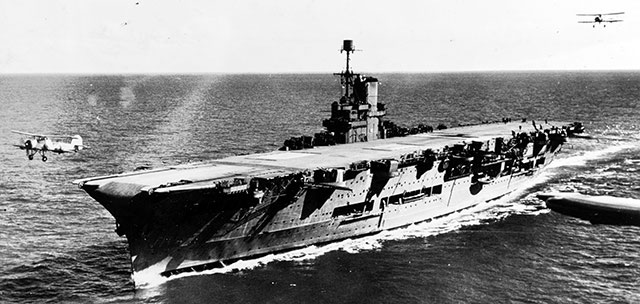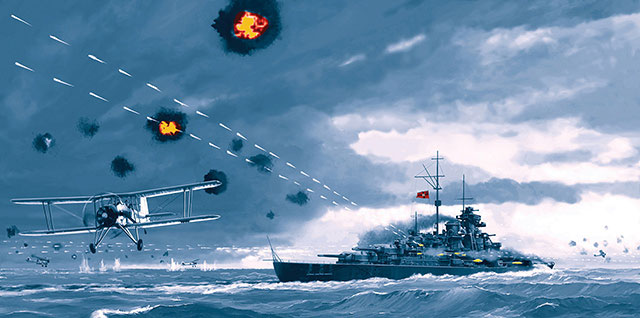If We Didn’t Fly There Would Be No Tomorrow
In this specially adapted extract from the book ‘Bismarck: 24 Hours to Doom’, by Iain Ballantyne, we ride with Canadian-born Fleet Air Arm aviator Terry Goddard, the Observer of a Swordfish torpedo-bomber sent to try and cripple the famous German high seas raider.
26 May 1941
7.00PM – HMS Ark Royal’s Bid
It is time for another set of contenders to climb into the ring for a round with the heavyweight. The battlecruiser HMS Hood tried on 24 May and was blown apart. Three days later aviators aboard the carrier HMS Ark Royal are being called forward, asked to inflict some kind of decisive blow to slow down Bismarck.
The Swordfish is deceptively antiquated looking. Though a biplane that chugs through the air sounding like an aerial tractor, it is not actually that old, having entered Fleet Air Arm service in 1937. It won its spurs in late 1940 by knocking out Italian battleships in Taranto harbour. The first U-boat sunk in the Second World War by the British was courtesy of a Swordfish using bombs but it is as a torpedo-bomber that it will achieve new fame.

HMS Ark Royal in WW2, operating Swordfish. Photo: USH&HC.
Slow, with only a top speed of 138 mph, its two wings give incredible lift. A monoplane needs around 30 knots of wind across the flight deck to take off from a carrier. The Swordfish can take off from a vessel at anchor (and even into the teeth of a gale). Constructed from wood, canvas and metal struts, it can survive hits that will destroy metal-skinned aircraft, for the simple reason that cannon shells and bullets pass right through it.
After the mission briefing for the attack on Bismarck comes the sitting and waiting for take-off. It is inevitable people ponder their mortality and chances of survival. Terry Goddard recognises that dreadful weather conditions will not be a barrier to the mission. ‘We knew perfectly well we were gonna fly, because if we didn’t fly there would be no tomorrow for us. We had to fly and weather be darned.’
The aircrews feel the weight of expectation, of history itself – the fate of the Navy and the nation, also the Fleet Air Arm’s honour all pressing down on their shoulders. ‘It is the sitting around that gnaws at you. You’re thinking rather than doing, which is worrisome. Once you start doing things the worry disappears. It must be tough on God. In war there aren’t any atheists – both sides are asking God for help. Most of us say prayers for him to help us. I know I did. Often. Fortunately he was on my side…’
Fifteen Swordfish are ranged on the flight deck, herring bone fashion, all fuelled up and each armed with a single 18-inch torpedo, ready to go.
7.10PM – Stormy Take-off
With waves crashing over Ark Royal’s bows, the Swordfish are launched, clawing their way into the sky. ‘One by one, the batsman, the deck control officer, leads you forward – and you just sit and wait, look at the island waiting for the green flag and away you go. The ship is steering into wind, actually on this occasion slowed down, so there wasn’t too much wind going over the deck. There’s green water coming over the bow. In my aircraft – Swordfish 5K – Stan Keane was the pilot, I was the Navigator and Milliner was the Air Gunner. He was responsible for working the radio. I’m responsible for getting us there and Stan is responsible for flying the aircraft and carrying out the attack. The ship was taking green water. The bow was going up and down 60ft. It was raining, windy and the ship was rolling and pitching but there was no problem in take off, we were airborne before we passed the island.’
Once in the air, the crew of Swordfish 5K formulates a plan of attack, though communication within the cockpit is difficult, what with a 110-knot wind and roar of the aircraft’s engine. They shout at each other down an interconnecting rubber voice pipe.

Swordfish torpedo-bombers attack battleship Bismarck. Image: Dennis Andrews. www.dennisandrewsart.co.uk
8.47PM – Fire-spitting Monster
Battling the gale, blown sideways, almost negating their forward momentum, the Swordfish drop from the clouds to make their attack runs. As they sight oncoming aircraft, lookouts aboard Bismarck scream: ‘Alarm!’
Klaxons blare throughout the German battleship. Bismarck takes violent evasive action, her anti-aircraft guns hurling a storm of steel at the British biplanes. Bismarck even fires her main 15-inch guns, the shells sending up tall plumes of spray, hoping to literally knock Swordfish out of the sky. Soon Swordfish 5K will be taking her turn at jousting with the enemy, provided she can find the target.
Terry Goddard looks anxiously over the side of the cockpit for some sign of Bismarck. ‘The whole aircraft shook as if there were a number of express trains roaring by us. We figured Bismarck had opened fire on us. In actual fact she had opened fire on [the nearby cruiser] Sheffield, but…we had found her. So, down we went. Ice was peeling off the wings, couldn’t see a bloody thing. The altimeter is spinning, spinning, spinning and then we break into the clear about 600ft and there’s Bismarck on our starboard bow. She was a fire-spitting monster. Everything was coming at us and she was illuminated…awesome. This ship was just magnificent. It looked exactly like a battleship should, I mean scary and everything but just a beautiful ship.
Once the attack has started it’s all about the pilot. The Observer and the Air Gunner, we just stand by and get really excited watching what is going on. You are not thinking you are going to be killed, you’re thinking you’re going to hit the bastard and that’s it. The more you turn [the aircraft] around, and the more you frig around, the more chance they get to hit you, so we just went straight in. We got as low on the deck as we could and went straight. Bismarck was on the port side and she just got bigger and bigger. The flak is bursting over our head. Well above us. The small arms fire is pretty well all around us – and hitting us every once in a while – but we get in to drop the torpedo…do a quick turn away.
Looking back shortly after the turn I see a large black and white explosion on the Bismarck. It is high and wide. Obviously it is a torpedo hit. There is no other aircraft anywhere near us and there is no doubt it was the torpedo we had just dropped. I tell Stan, he grunts – he’s busy doing various manoeuvres on the deck – I give a message to the Air Gunner that we have scored a hit. Milliner thought he’d seen something too. Right after the attack the shooting stopped. We were in the clear. She wasn’t firing at us. Ark Royal requests us to repeat the message. Then we climb back up into the clag and this time it is about 6,000ft that we broke clear. About five minutes later we saw another Swordfish well ahead. We increase speed, join up with him. It’s David Godfrey-Faussett [the other aircraft’s pilot] smoking a big cigar and with a smile on his face. I didn’t like his course so we broke away and we headed off on our own.’
11.30PM – Mission Failure?
With Swordfish landing back aboard Ark Royal, and their crews filing reports, it is decided the balance of probability is that Bismarck has not been damaged. This is despite claims in the briefing room by some aviators that they managed torpedo hits on the German giant. ‘Command was very reluctant to accept that there were any. I told them three or four times that we had scored a hit and they ignored me. Finally, when Sheffield sent a report that Bismarck was steering north-east, they suddenly realised that something had happened.’
In other words, the enemy vessel is not heading towards the sanctuary of Brest on the French Atlantic coast, but rather back to where the Home Fleet battleships are closing. Bismarck’s change in direction cannot be happening by choice.
‘They ultimately accepted that there were two hits…we had attacked after the torpedo had hit the rudder. We were the last aircraft to attack the Bismarck, then or any other day.’
Now it was down to the rest of British fleet to destroy the German behemoth…

For the rest of the exciting, action-packed story buy ‘Bismarck: 24 Hours to Doom’ (£2.99 ebook/£5.99 paperback) which is published by Ipso Books

Swordfish aviator Terry Goddard aboard a Royal Navy aircraft carrier during WW2. Photo: © Goddard Collection.
Commander Terry Goddard, Royal Canadian Navy (Retd) had an extraordinary war and was awarded the Distinguished Service Cross (DSC) in 1943 ‘for outstanding bravery & skill’. After the Bismarck Action, Terry remained with 818 NAS for some time before joining 803 NAS. He saw further action, flying in Fulmars from the carrier Formidable during operations in the Indian Ocean. His aircraft engaged in a dogfight with a Japanese fighter, narrowly evading destruction. Switched to the Mediterranean, Terry at one time had command of 821 NAS, equipped with Albacore torpedo-bombers. Flying from North Africa and Malta, 821 NAS carried out anti-shipping and mine laying tasks, path-finding for RAF Wellington bombers and anti-submarine protection of the Sicily invasion force. Post-war Lieutenant Goddard served in the Royal Canadian Navy (RCN) destroyer HMCS Haida, before promotion to Lt Cdr and taking command of the RCN Fleet Air Arm’s 826 Squadron and the 18th Carrier Air Group flying from the carrier HMCS Magnificent. Cdr Goddard ended his naval career as Staff Officer Operations at NATO’s Commander-in-Chief Eastern Atlantic (CINCEASTLANT). Terry lived for many years in peaceful retirement with his wife Cora, in Ontario, Canada. They were together for more than 30 years. Terry was 96 when he passed away in March 2016. ‘Bismarck: 24 Hours to Doom’ also contains details of Terry’s war service both before and after the May 1941 battle.
Comments
Comments are closed.